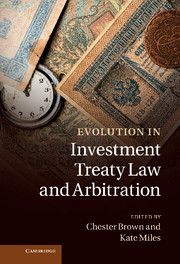Book contents
- Frontmatter
- Contents
- Contributors
- Editors' preface and acknowledgements
- Table of cases
- Table of Treaties
- Part I Introduction
- Part II Shifts in fundamental character
- Part III Actors in international investment law
- Part IV The new significance of procedure
- 15 The new rules on participation of non-disputing parties in ICSID arbitration: Blessing or curse?
- 16 The role of procedure in the development of investment law: The case of Section B of Chapter 11 of NAFTA
- 17 Navigating the parallel universe of investor–State arbitrations under the UNCITRAL Rules
- 18 The scope of ‘amount of compensation’ dispute-resolution clauses in investment treaties
- 19 Interference by a local court and a failure to enforce: Actionable under a bilateral investment treaty?
- 20 Bias challenges in investor–State arbitration: Lessons from international commercial arbitration
- Part V Engagement with cross-cutting issues
- Part VI Conclusions
- Index
- References
18 - The scope of ‘amount of compensation’ dispute-resolution clauses in investment treaties
from Part IV - The new significance of procedure
Published online by Cambridge University Press: 05 December 2011
- Frontmatter
- Contents
- Contributors
- Editors' preface and acknowledgements
- Table of cases
- Table of Treaties
- Part I Introduction
- Part II Shifts in fundamental character
- Part III Actors in international investment law
- Part IV The new significance of procedure
- 15 The new rules on participation of non-disputing parties in ICSID arbitration: Blessing or curse?
- 16 The role of procedure in the development of investment law: The case of Section B of Chapter 11 of NAFTA
- 17 Navigating the parallel universe of investor–State arbitrations under the UNCITRAL Rules
- 18 The scope of ‘amount of compensation’ dispute-resolution clauses in investment treaties
- 19 Interference by a local court and a failure to enforce: Actionable under a bilateral investment treaty?
- 20 Bias challenges in investor–State arbitration: Lessons from international commercial arbitration
- Part V Engagement with cross-cutting issues
- Part VI Conclusions
- Index
- References
Summary
Introduction
An investment tribunal's determination of the jurisdiction granted to it by an investment treaty has often given rise to considerable controversy. The meaning of words such as ‘investments’ or ‘investors’ for purposes of establishing jurisdiction or the ability of most-favoured nation provisions to import external dispute-resolution procedures have generated much debate. These issues are now well traversed (but still not fully resolved) in numerous awards and in scholarly literature. This chapter concerns a jurisdictional issue of a more recent vintage and about which comparatively little has yet been written. The issue in question relates to whether investment treaty dispute-resolution clauses that provide arbitral jurisdiction over disputes as to the ‘amount of compensation’ or ‘compensation due’ (i) permit a tribunal to determine an investor's entitlement to compensation (i.e. determining whether the host State breached the treaty's substantive provisions, thus triggering compensation obligations) and also to quantify such compensation (i.e. calculating the amount of compensation to be paid to the investor as a result of a treaty breach); or (ii) limit a tribunal solely to quantifying the amount of compensation.
For the purposes of this present chapter, ‘amount of compensation’ clauses can be said, for example, to take the form (with variations) of Article 13(3) of the 1988 China–New Zealand bilateral investment treaty (BIT):
If a dispute involving the amount of compensation resulting from expropriation referred to in Article 6 cannot be settled within six months after resort to negotiation . . . it may be submitted to an international tribunal established by both parties.
- Type
- Chapter
- Information
- Evolution in Investment Treaty Law and Arbitration , pp. 409 - 428Publisher: Cambridge University PressPrint publication year: 2011



